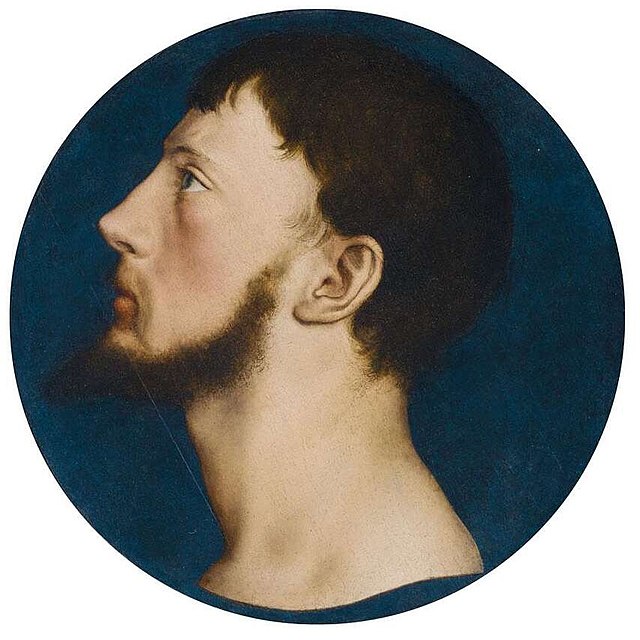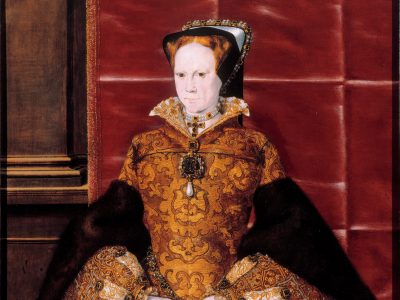Candlemas Day 1554, 470 years ago, was a key day in the rising known to history as Wyaytt’s Rebellion. Intended to frustrate the proposed marriage of Queen Mary I to Philip, heir to the Spanish dominions, the rebellion had had to be brought forward by a couple of months and only one part of it, the Kentish uprising, actually made any significant impact. There is a reasonable narrative account, with occasional errors and omissions of relevant detail, on Wikipedia at Wyatt's rebellion
There is a biography of Wyatt on the same site at Thomas Wyatt the Younger
Sir Thomas Wyatt the Younger by Hans Holbein the Younger circa 1540-42
Image: Wikipedia
February 2nd saw Sir Thomas Wyatt and his men occupy Southwark, but only to find London Bridge closed to them and the guns of the Tower of London trained on Southwark. Meanwhile in the City of London Queen Mary met at Guildhall with representatives of civic life and delivered a defiant and rousing speech which was very much in the style associated with her half-sister when she was Queen. The effect was to rally the Londoners to the monarch in the wake of the embarrassing desertion of the London militia to the rebels a few days earlier at Dartford.
Queen Mary I
A portrait probably from 1554 which is discussed at Mary I (1516-1558) - Society of Antiquaries of London
Image: Society of Antiquaries
With the Crown’s troops outnumbering the rebels and unable to use London Bridge, and urged on by the authorities in Southwark, on February 6th Wyatt moved west to Kingston. This was the next bridge across the Thames, and had been partially broken. Having repaired it and crossing Wyatt then moved on London but his campaign collapsed when he was trapped on The Strand between Royalist forces from Whitehall and the closed entry to the city at Ludgate - a defeat similar to that of the Earl of Essex in 1601. His surrender sent him to the Tower and eventually to be beheaded on the scaffold Tower Hill on April 11th. Others who were to be executed as a direct or indirect consequence of their involvement were not just some of the London troops who had deserted but also Lady Jane and Guildford Dudley and her father the Duke of Suffolk and one of his brothers, Lord Thomas Grey. The uprising also placed in danger of a similar fate both the Lady Elizabeth and the Earl of Devon. How much either of them knew about the rebellion in advance remains unclear.
The standard academic account of the rebellion in David Loades’ Two Tudor Conspiracies. I recently read the second, somewhat revised, edition of this book, the first of many that Professor Loades wrote on the reign of Queen Mary, as well as wider topics. In his later years he was someone I encountered as a scholarly and amiable participant at seminars on Church history in Oxford.
Reading the book with its new introduction as well as having read others by Professor Loades I both enjoyed it and learned much from it about both of the conspiracies it covers. I would certainly recommend it to anyone interested in the subject.
I did however think that in respect of the Wyatt conspiracy the matter of religion was not given as much prominence as it might. This is no doubt due to the fact that Wyatt told his followers very clearly not to raise the matter, and he relied on appealing to an anti-Spanish, anti-foreign rule rhetoric. However the somewhat obscure religious views of Wyatt and his co-conspirators must have been significant. One of them, the Duke of Suffolk, father of Lady Jane Grey, had definitely ‘advanced’ evangelical beliefs and corresponded with continental reformers. I rather wonder if Professor Loades was a student in an Eltonian environment of 1960s Cambridge that put less emphasis on religion as a compelling commitment than would be done by historians these days. Kent was a county with varied ecclesiastical traditions in the sixteenth century, but Lollardy and early reformist and evangelical ideas had been and were well established there.
The other aspect of the book that left me wanting more was also in respect of the county of Kent. For a variety of reasons, not least perhaps its particular social and cultural traditions and demography, Kent was a county that in the fourteenth and fifteenth centuries was prone to rise, or be roused, in rebellion. If the most famous instance was in 1381, there was also Jack Cade’s rebellion in 1450, the campaign of the Bastard of Fauconberg in 1471 - which was very similar to Wyatt in its stalling at Southwark and attempt to cross the Thames at Kingston - and the attempt to raise support for Buckingham at Tonbridge in 1483. Add to that the use of Blackheath as a point of assembly by the Cornish rebels in 1497 and its continuing strategic significance in respect of both London and of the continent, and Kent with its turbulent social and religious background needed, I felt, more analysis than the book gives.
From this and other reading Wyatt emerges as a not untypical man of his age, notable as a daring military figure, able to motivate the men under him, but politically not very adept or adroit, one who could possibly have saved himself and others had he backed down in time.




No comments:
Post a Comment